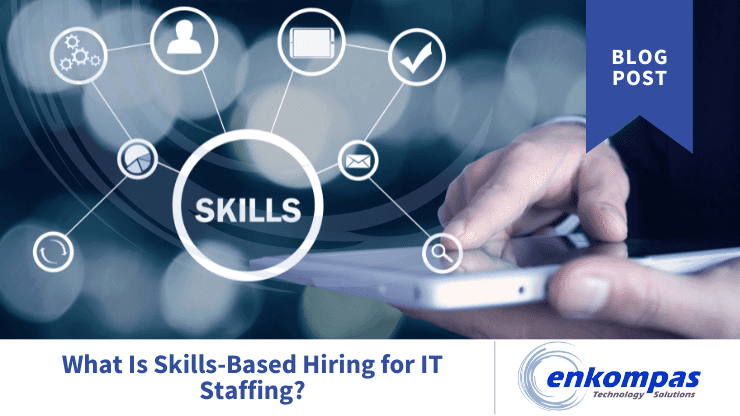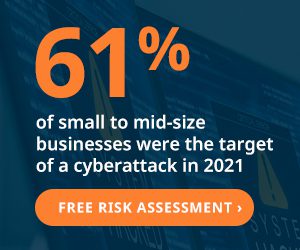Skills-Based Hiring
Many companies are shifting to a skills-based hiring model when it comes to recruiting the right IT talent. As opposed to traditional, credentials-based hiring, skills-based hiring is a growing trend in IT staffing, focused on a candidate’s actual abilities and practical skills rather than solely relying on formal education or certifications.
This shift represents a more pragmatic approach to IT staffing, acknowledging that in a fast-evolving field like technology, practical skills and adaptability are often more valuable than traditional credentials alone. Let’s look at what skills-based hiring involves, as well as what companies need to do to shift to this model for finding top IT talent.
Skills-Based Hiring Model for IT
For starters, skills-based hiring emphasizes practical skills. Employers are increasingly valuing hands-on experience and demonstrable skills over academic degrees or certifications alone. This approach recognizes that many IT skills can be self-taught or acquired through non-traditional means.
Performance-Based Assessments
As a result, hiring managers are turning to performance-based assessments which require candidates to demonstrate they possess a specific skill needed for the role. These assessments are designed to evaluate the candidate’s real-world capabilities, ensuring they are up to the tasks required to perform the job effectively.
The Importance of Portfolios
Similarly, the skills-based hiring model recognized the importance of a candidate’s portfolio. For many IT roles, a strong portfolio of projects or contributions to open-source software can be more valuable than a degree from a prestigious university.
Addressing Skills Gaps
Next, the approach is a more effective means of addressing skills gaps in their IT departments. The skills-based approach helps companies fill positions more effectively by focusing on the specific skills needed for a role rather than rigid qualification requirements.
Continuous Learning, Soft Skills, and More
In addition, this hiring trend focused on candidates who can demonstrate their commitment to continuous learning. The approach recognizes that the ability to continuously learn and adapt is essential due to the ever-accelerating pace of change in technology. Further, the approach emphasizes interpersonal and other non-technical skills that will improve job performance.
Finally, the model helps to reduce bias and foster diversity and inclusion. By focusing on measurable skills rather than credentials, this approach can potentially reduce unconscious biases in the hiring process. Plus, skills-based hiring can promote diversity by opening opportunities to candidates from non-traditional backgrounds who may otherwise be overlooked because they developed relevant skills through alternative paths.
How to Adopt a Skills-Based Hiring Process
Adopting a skills-based hiring process involves several key steps and strategies. If you want to implement this approach for IT staffing, here’s a list of key strategies that will help your organization implement a skills-based paradigm.
1. Identify core competencies:
– Define the specific skills and abilities crucial for each role
– Focus on both technical and soft skills
2. Develop skill assessments:
– Create practical tests or projects that simulate real work scenarios
– Use coding challenges, case studies, or problem-solving exercises
3. Implement blind resume screening:
– Remove identifying information like names, schools, and dates from resumes
– Focus on skills, experiences, and achievements
– Remove identifying information like names, schools, and dates from resumes
– Focus on skills, experiences, and achievements
4. Utilize structured interviews:
– Develop interview questions that assess specific skills and competencies
– Use behavioral and situational questions to evaluate practical abilities
5. Incorporate work simulations:
– Design job-specific tasks or projects for candidates to complete
– Evaluate performance in real-time or through submitted work
6. Adopt skills-based job descriptions:
– Rewrite job postings to emphasize required skills over credentials
– Use inclusive language to attract diverse candidates
7. Leverage technology:
– Use AI-powered tools to match candidate skills with job requirements
– Implement applicant tracking systems that focus on skills rather than keywords
8. Measure and refine:
– Track the success of hires made through skills-based methods
– Continuously improve the process based on outcomes and feedback
Adopt a Skills-Based Culture
Ideally, companies that decide to adopt a skill-based model will weave the concept into their IT departments, rather than limit the idea to the hiring process. Adopting a culture of continuous learning allows IT staff to grow their skills, creating a win-win scenario for staff and the company. Fostering a learning environment where IT staff routinely pick up new skills can reduce the need to hire from outside the organization in the future.
For example, continuously update skill requirements for each role in IT. As industry trends and technological advancements evolve, so must your existing IT staff. In addition, apply the same principles to internal promotions and transfers. Based decisions on skills required for the roles, rather than seniority or other traditional criteria. Also, encourage upskilling and reskilling within the company, so that your staff has the best opportunities for advancement based on skills needed to fill new roles.
Similarly, organizations can create skills-based career paths – where the routes to progressing within the organization are based on acquiring new skills. Implement mentoring programs to provide staff with the opportunities needed for skill development.
Why a Skills-Based Model
By implementing these strategies, companies can shift towards a more effective and equitable hiring process that focuses on candidates’ actual abilities rather than traditional credentials. This approach can lead to a more diverse and skilled workforce, better suited to meet the evolving needs of the IT industry.
About enkompas Technology Solutions
Contact us for more information on how enkompas Technology Solutions strategically helps organizations improve the speed and quality of their IT Staffing needs – including through the use of skills-based assessments.
enkompas powers your entire technology environment, working closely with your team to provide strategic enterprise technology solutions. With nearly 30 years of experience as a trusted managed IT services partner, our goal is to help you build a secure, scalable organizational roadmap.


